Songwei Liu
GQSA: Group Quantization and Sparsity for Accelerating Large Language Model Inference
Dec 23, 2024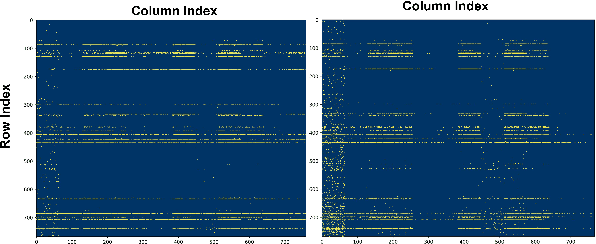
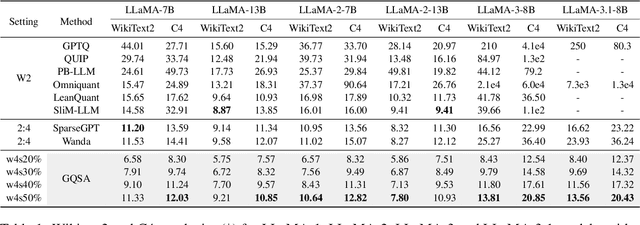
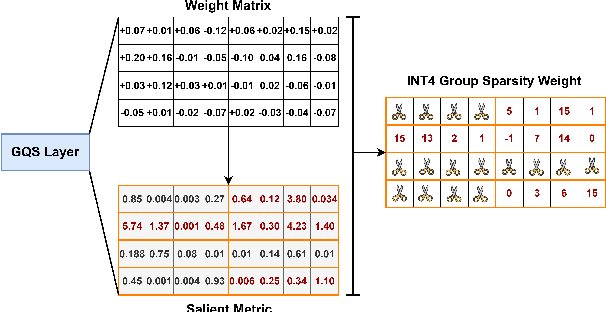
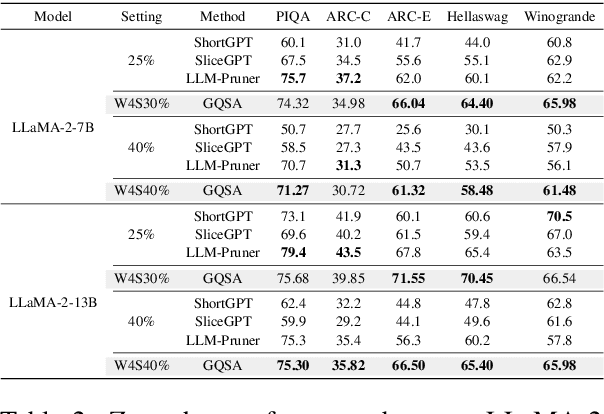
Abstract:With the rapid growth in the scale and complexity of large language models (LLMs), the costs of training and inference have risen substantially. Model compression has emerged as a mainstream solution to reduce memory usage and computational overhead. This paper presents Group Quantization and Sparse Acceleration (\textbf{GQSA}), a novel compression technique tailored for LLMs. Traditional methods typically focus exclusively on either quantization or sparsification, but relying on a single strategy often results in significant performance loss at high compression rates. In contrast, GQSA integrates quantization and sparsification in a tightly coupled manner, leveraging GPU-friendly structured group sparsity and quantization for efficient acceleration. The proposed method consists of three key steps. First, GQSA applies group structured pruning to adhere to GPU-friendly sparse pattern constraints. Second, a two-stage sparsity-aware training process is employed to maximize performance retention after compression. Finally, the framework adopts the Block Sparse Row (BSR) format to enable practical deployment and efficient execution. Experimental results on the LLaMA model family show that GQSA achieves an excellent balance between model speed and accuracy. Furthermore, on the latest LLaMA-3 and LLaMA-3.1 models, GQSA outperforms existing LLM compression techniques significantly.
Timely reliable Bayesian decision-making enabled using memristors
Dec 07, 2024Abstract:Brains perform timely reliable decision-making by Bayes theorem. Bayes theorem quantifies events as probabilities and, through probability rules, renders the decisions. Learning from this, applying Bayes theorem in practical problems can visualize the potential risks and decision confidence, thereby enabling efficient user-scene interactions. However, given the probabilistic nature, implementing Bayes theorem with the conventional deterministic computing can inevitably induce excessive computational cost and decision latency. Herein, we propose a probabilistic computing approach using memristors to implement Bayes theorem. We integrate volatile memristors with Boolean logics and, by exploiting the volatile stochastic switching of the memristors, realize Boolean operations with statistical probabilities and correlations, key for enabling Bayes theorem. To practically demonstrate the effectiveness of our memristor-enabled Bayes theorem approach in user-scene interactions, we design lightweight Bayesian inference and fusion operators using our probabilistic logics and apply the operators in road scene parsing for self-driving, including route planning and obstacle detection. The results show that our operators can achieve reliable decisions at a rate over 2,500 frames per second, outperforming human decision-making and the existing driving assistance systems.
ABQ-LLM: Arbitrary-Bit Quantized Inference Acceleration for Large Language Models
Aug 16, 2024



Abstract:Large Language Models (LLMs) have revolutionized natural language processing tasks. However, their practical application is constrained by substantial memory and computational demands. Post-training quantization (PTQ) is considered an effective method to accelerate LLM inference. Despite its growing popularity in LLM model compression, PTQ deployment faces two major challenges. First, low-bit quantization leads to performance degradation. Second, restricted by the limited integer computing unit type on GPUs, quantized matrix operations with different precisions cannot be effectively accelerated. To address these issues, we introduce a novel arbitrary-bit quantization algorithm and inference framework, ABQ-LLM. It achieves superior performance across various quantization settings and enables efficient arbitrary-precision quantized inference on the GPU. ABQ-LLM introduces several key innovations: (1) a distribution correction method for transformer blocks to mitigate distribution differences caused by full quantization of weights and activations, improving performance at low bit-widths. (2) the bit balance strategy to counteract performance degradation from asymmetric distribution issues at very low bit-widths (e.g., 2-bit). (3) an innovative quantization acceleration framework that reconstructs the quantization matrix multiplication of arbitrary precision combinations based on BTC (Binary TensorCore) equivalents, gets rid of the limitations of INT4/INT8 computing units. ABQ-LLM can convert each component bit width gain into actual acceleration gain, maximizing performance under mixed precision(e.g., W6A6, W2A8). Based on W2*A8 quantization configuration on LLaMA-7B model, it achieved a WikiText2 perplexity of 7.59 (2.17$\downarrow $ vs 9.76 in AffineQuant). Compared to SmoothQuant, we realized 1.6$\times$ acceleration improvement and 2.7$\times$ memory compression gain.
Hybrid SD: Edge-Cloud Collaborative Inference for Stable Diffusion Models
Aug 13, 2024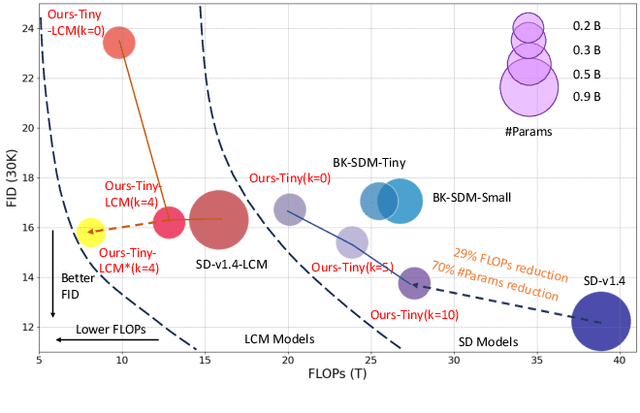
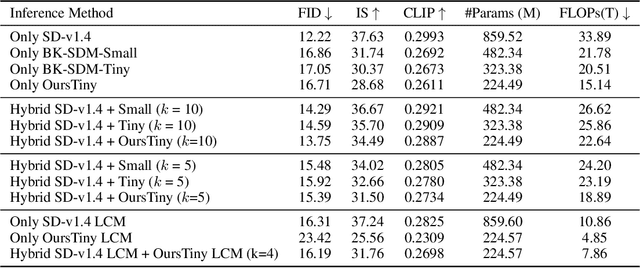
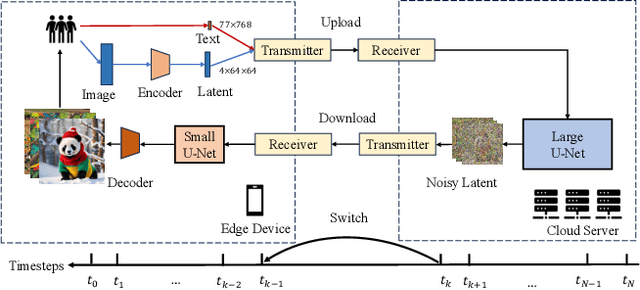
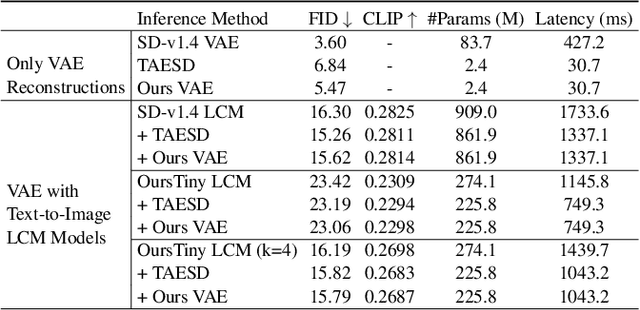
Abstract:Stable Diffusion Models (SDMs) have shown remarkable proficiency in image synthesis. However, their broad application is impeded by their large model sizes and intensive computational requirements, which typically require expensive cloud servers for deployment. On the flip side, while there are many compact models tailored for edge devices that can reduce these demands, they often compromise on semantic integrity and visual quality when compared to full-sized SDMs. To bridge this gap, we introduce Hybrid SD, an innovative, training-free SDMs inference framework designed for edge-cloud collaborative inference. Hybrid SD distributes the early steps of the diffusion process to the large models deployed on cloud servers, enhancing semantic planning. Furthermore, small efficient models deployed on edge devices can be integrated for refining visual details in the later stages. Acknowledging the diversity of edge devices with differing computational and storage capacities, we employ structural pruning to the SDMs U-Net and train a lightweight VAE. Empirical evaluations demonstrate that our compressed models achieve state-of-the-art parameter efficiency (225.8M) on edge devices with competitive image quality. Additionally, Hybrid SD reduces the cloud cost by 66% with edge-cloud collaborative inference.
FoldGPT: Simple and Effective Large Language Model Compression Scheme
Jul 01, 2024Abstract:The demand for deploying large language models(LLMs) on mobile devices continues to increase, driven by escalating data security concerns and cloud costs. However, network bandwidth and memory limitations pose challenges for deploying billion-level models on mobile devices. In this study, we investigate the outputs of different layers across various scales of LLMs and found that the outputs of most layers exhibit significant similarity. Moreover, this similarity becomes more pronounced as the model size increases, indicating substantial redundancy in the depth direction of the LLMs. Based on this observation, we propose an efficient model volume compression strategy, termed FoldGPT, which combines block removal and block parameter sharing.This strategy consists of three parts: (1) Based on the learnable gating parameters, we determine the block importance ranking while modeling the coupling effect between blocks. Then we delete some redundant layers based on the given removal rate. (2) For the retained blocks, we apply a specially designed group parameter sharing strategy, where blocks within the same group share identical weights, significantly compressing the number of parameters and slightly reducing latency overhead. (3) After sharing these Blocks, we "cure" the mismatch caused by sparsity with a minor amount of fine-tuning and introduce a tail-layer distillation strategy to improve the performance. Experiments demonstrate that FoldGPT outperforms previous state-of-the-art(SOTA) methods in efficient model compression, demonstrating the feasibility of achieving model lightweighting through straightforward block removal and parameter sharing.
Local stochastic computing using memristor-enabled stochastic logics
Feb 25, 2024Abstract:Stochastic computing offers a probabilistic approach to address challenges posed by problems with uncertainty and noise in various fields, particularly machine learning. The realization of stochastic computing, however, faces the limitation of developing reliable stochastic logics. Here, we present stochastic logics development using memristors. Specifically, we integrate memristors into logic circuits to design the stochastic logics, wherein the inherent stochasticity in memristor switching is harnessed to enable stochastic number encoding and processing with well-regulated probabilities and correlations. As a practical application of the stochastic logics, we design a compact stochastic Roberts cross operator for edge detection. Remarkably, the operator demonstrates exceptional contour and texture extractions, even in the presence of 50% noise, and owning to the probabilistic nature and compact design, the operator can consume 95% less computational costs required by conventional binary computing. The results underscore the great potential of our stochastic computing approach as a lightweight local solution to machine learning challenges in autonomous driving, virtual reality, medical diagnosis, industrial automation, and beyond.
SparseByteNN: A Novel Mobile Inference Acceleration Framework Based on Fine-Grained Group Sparsity
Oct 30, 2023



Abstract:To address the challenge of increasing network size, researchers have developed sparse models through network pruning. However, maintaining model accuracy while achieving significant speedups on general computing devices remains an open problem. In this paper, we present a novel mobile inference acceleration framework SparseByteNN, which leverages fine-grained kernel sparsity to achieve real-time execution as well as high accuracy. Our framework consists of two parts: (a) A fine-grained kernel sparsity schema with a sparsity granularity between structured pruning and unstructured pruning. It designs multiple sparse patterns for different operators. Combined with our proposed whole network rearrangement strategy, the schema achieves a high compression rate and high precision at the same time. (b) Inference engine co-optimized with the sparse pattern. The conventional wisdom is that this reduction in theoretical FLOPs does not translate into real-world efficiency gains. We aim to correct this misconception by introducing a family of efficient sparse kernels for ARM and WebAssembly. Equipped with our efficient implementation of sparse primitives, we show that sparse versions of MobileNet-v1 outperform strong dense baselines on the efficiency-accuracy curve. Experimental results on Qualcomm 855 show that for 30% sparse MobileNet-v1, SparseByteNN achieves 1.27x speedup over the dense version and 1.29x speedup over the state-of-the-art sparse inference engine MNN with a slight accuracy drop of 0.224%. The source code of SparseByteNN will be available at https://github.com/lswzjuer/SparseByteNN
Unfolding Once is Enough: A Deployment-Friendly Transformer Unit for Super-Resolution
Aug 05, 2023



Abstract:Recent years have witnessed a few attempts of vision transformers for single image super-resolution (SISR). Since the high resolution of intermediate features in SISR models increases memory and computational requirements, efficient SISR transformers are more favored. Based on some popular transformer backbone, many methods have explored reasonable schemes to reduce the computational complexity of the self-attention module while achieving impressive performance. However, these methods only focus on the performance on the training platform (e.g., Pytorch/Tensorflow) without further optimization for the deployment platform (e.g., TensorRT). Therefore, they inevitably contain some redundant operators, posing challenges for subsequent deployment in real-world applications. In this paper, we propose a deployment-friendly transformer unit, namely UFONE (i.e., UnFolding ONce is Enough), to alleviate these problems. In each UFONE, we introduce an Inner-patch Transformer Layer (ITL) to efficiently reconstruct the local structural information from patches and a Spatial-Aware Layer (SAL) to exploit the long-range dependencies between patches. Based on UFONE, we propose a Deployment-friendly Inner-patch Transformer Network (DITN) for the SISR task, which can achieve favorable performance with low latency and memory usage on both training and deployment platforms. Furthermore, to further boost the deployment efficiency of the proposed DITN on TensorRT, we also provide an efficient substitution for layer normalization and propose a fusion optimization strategy for specific operators. Extensive experiments show that our models can achieve competitive results in terms of qualitative and quantitative performance with high deployment efficiency. Code is available at \url{https://github.com/yongliuy/DITN}.
Residual Local Feature Network for Efficient Super-Resolution
May 16, 2022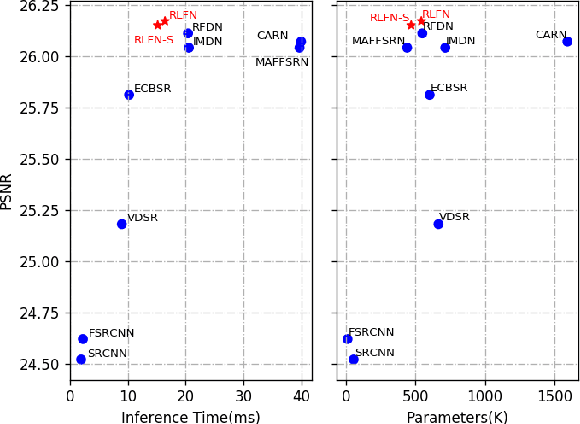
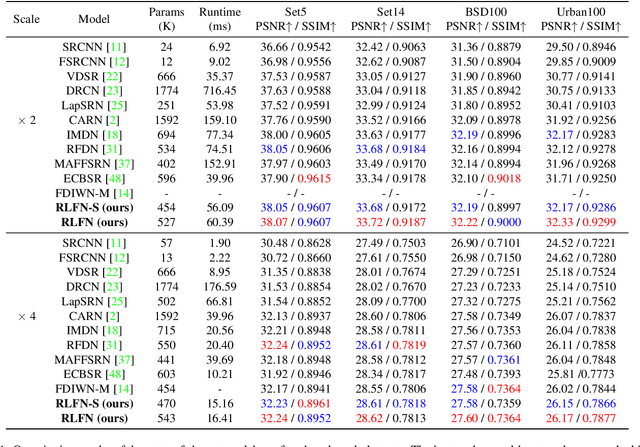
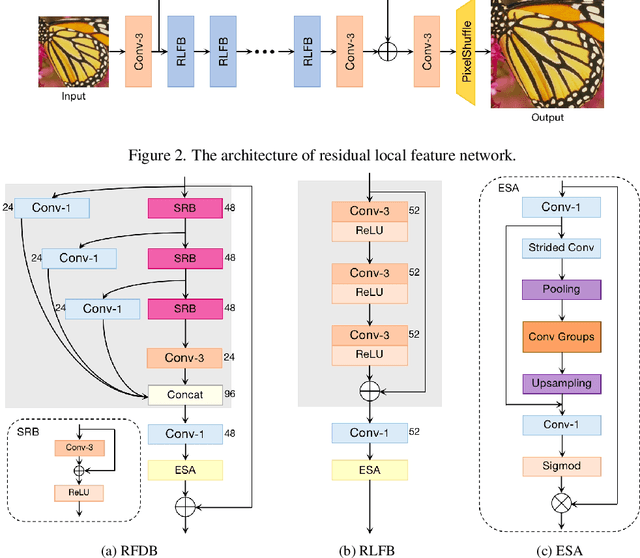

Abstract:Deep learning based approaches has achieved great performance in single image super-resolution (SISR). However, recent advances in efficient super-resolution focus on reducing the number of parameters and FLOPs, and they aggregate more powerful features by improving feature utilization through complex layer connection strategies. These structures may not be necessary to achieve higher running speed, which makes them difficult to be deployed to resource-constrained devices. In this work, we propose a novel Residual Local Feature Network (RLFN). The main idea is using three convolutional layers for residual local feature learning to simplify feature aggregation, which achieves a good trade-off between model performance and inference time. Moreover, we revisit the popular contrastive loss and observe that the selection of intermediate features of its feature extractor has great influence on the performance. Besides, we propose a novel multi-stage warm-start training strategy. In each stage, the pre-trained weights from previous stages are utilized to improve the model performance. Combined with the improved contrastive loss and training strategy, the proposed RLFN outperforms all the state-of-the-art efficient image SR models in terms of runtime while maintaining both PSNR and SSIM for SR. In addition, we won the first place in the runtime track of the NTIRE 2022 efficient super-resolution challenge. Code will be available at https://github.com/fyan111/RLFN.
NTIRE 2022 Challenge on Efficient Super-Resolution: Methods and Results
May 11, 2022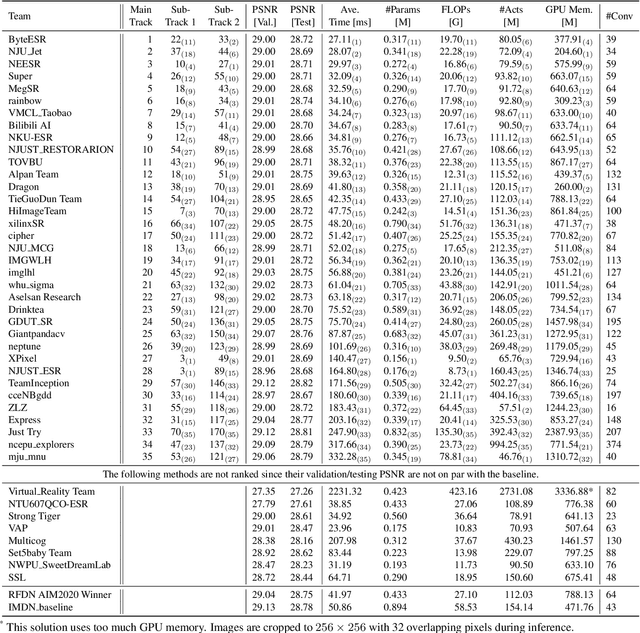
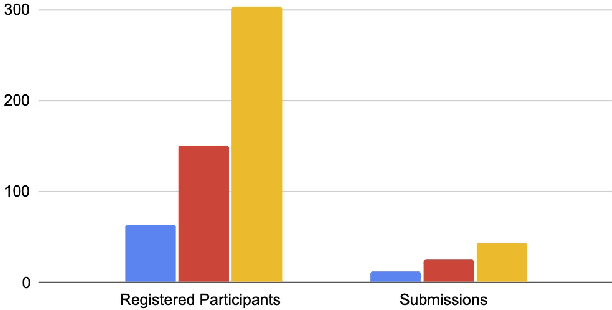
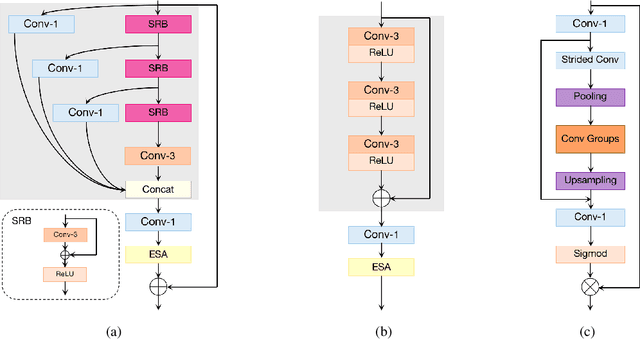
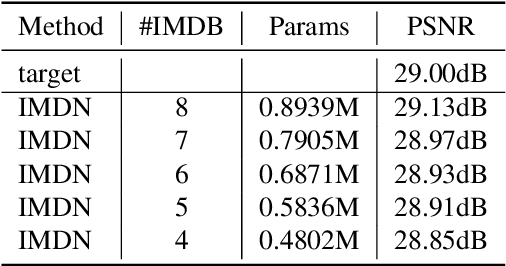
Abstract:This paper reviews the NTIRE 2022 challenge on efficient single image super-resolution with focus on the proposed solutions and results. The task of the challenge was to super-resolve an input image with a magnification factor of $\times$4 based on pairs of low and corresponding high resolution images. The aim was to design a network for single image super-resolution that achieved improvement of efficiency measured according to several metrics including runtime, parameters, FLOPs, activations, and memory consumption while at least maintaining the PSNR of 29.00dB on DIV2K validation set. IMDN is set as the baseline for efficiency measurement. The challenge had 3 tracks including the main track (runtime), sub-track one (model complexity), and sub-track two (overall performance). In the main track, the practical runtime performance of the submissions was evaluated. The rank of the teams were determined directly by the absolute value of the average runtime on the validation set and test set. In sub-track one, the number of parameters and FLOPs were considered. And the individual rankings of the two metrics were summed up to determine a final ranking in this track. In sub-track two, all of the five metrics mentioned in the description of the challenge including runtime, parameter count, FLOPs, activations, and memory consumption were considered. Similar to sub-track one, the rankings of five metrics were summed up to determine a final ranking. The challenge had 303 registered participants, and 43 teams made valid submissions. They gauge the state-of-the-art in efficient single image super-resolution.
 Add to Chrome
Add to Chrome Add to Firefox
Add to Firefox Add to Edge
Add to Edge